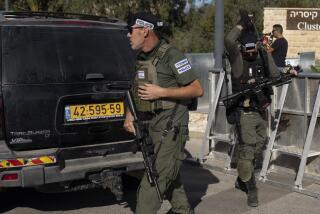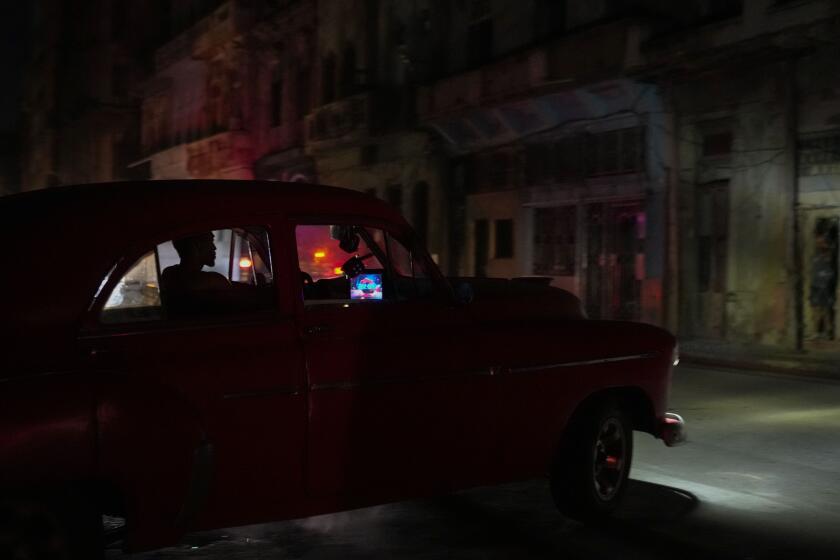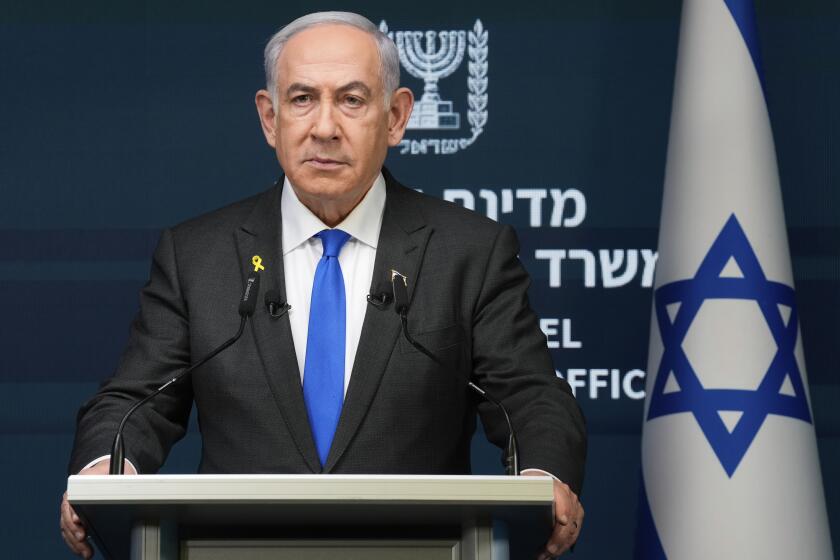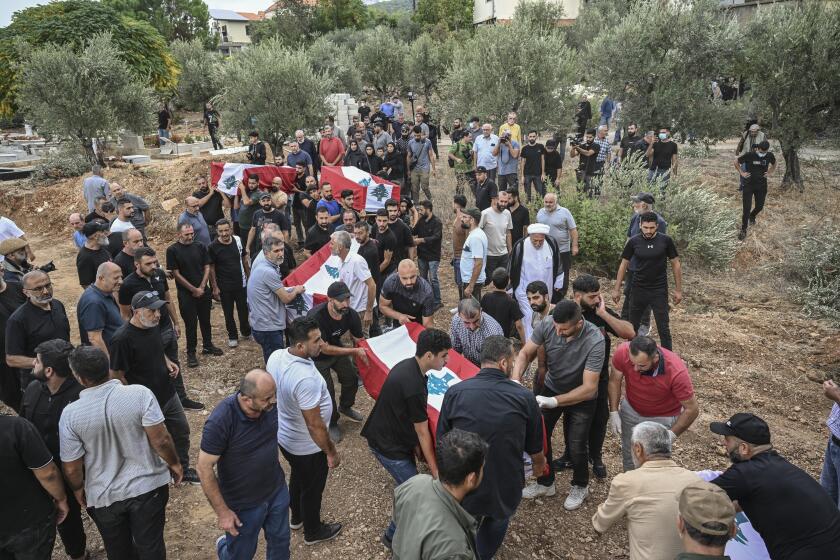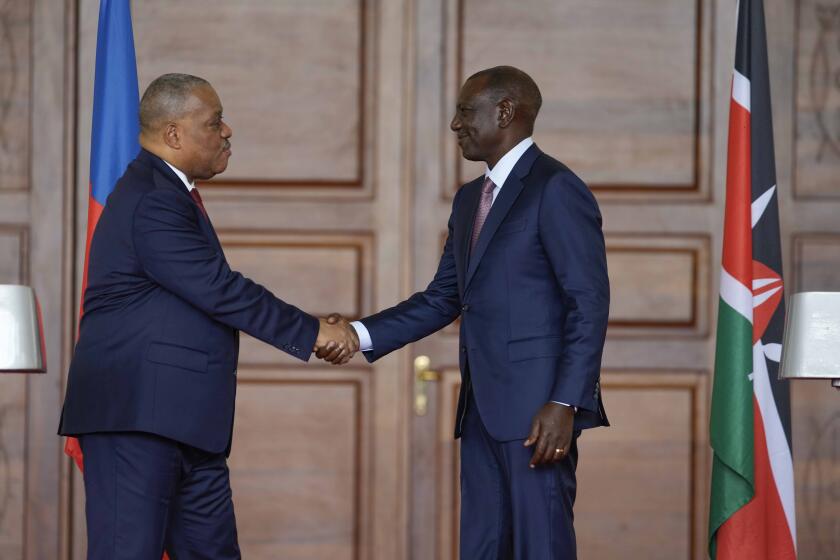‘Lessons of Rhodesia’ Debated : Vigilantism Growing Rapidly in S. Africa
An empty strip of land between the middle-class white suburb of Dan Pienaarville and the impoverished black ghetto of Munsieville has become a no-man’s-land, perhaps the future front line of the racial civil war that many South Africans fear is coming.
In Munsieville are militant black youths who say they are ready to die to bring an end to apartheid, South Africa’s system of racial separation and white-minority rule.
In Dan Pienaarville are frightened but determined whites, many of whom say flatly that they are ready to kill to uphold the only system they know and the only one they believe can work in South Africa.
Day and night, armed troops patrol the 400 yards between Munsieville and Dan Pienaarville, an expanse of waist-high grass and scattered trees, to keep the two communities apart.
“One day very soon, the kaffirs (a derogatory term for blacks) are going to come across that veld (field) to kill us, but we are going to get them first,” said Danie, a tall, broad-shouldered man who refused to give his last name. He and three friends, each with a pistol in his belt, checked their rifles and shotguns before going “on duty” patrolling the white subdivision in radio-equipped cars one night last week.
“The war is coming, and the only way that we whites can survive is to make sure we each kill 10 blacks,” Danie said. “That’s our intention.”
Although officially discouraged by the police, such armed white vigilante groups--or “citizen patrols,” as they prefer to be called--are being organized around most of South Africa’s major cities and in other towns like Krugersdorp, about 25 miles northwest of Johannesburg, where the racial unrest of the past year and a half has now spread.
These vigilantes draw on large home arsenals, some wear military-style uniforms and many are joining the “Fire Watch” national militia being established by the ultraright Afrikaner Resistance Movement.
Such actions are the most dramatic indication of the growing backlash among whites against the continuing civil strife and the government’s failure to end it with either tough police action or step-by-step reforms.
The vigilantes’ rapid growth also reflects the deepening siege mentality among the country’s 5 million whites. Many whites perceive themselves as not only losing political power and the privileges that apartheid has given them but also in danger of being overrun and killed by the 25 million blacks they now rule.
Amid the spread of both black attacks on whites and civilian white attacks on blacks, there are heightened fears, even within President Pieter W. Botha’s government, of a civil war.
‘Culture of Resistance’
“A culture of resistance is being born right in front of our eyes, and the problem facing us is to find a less, and not a more, violent means of change,” Frederik van Zyl Slabbert, former leader of the liberal white opposition Progressive Federal Party, said last week of the white backlash in Cape Town.
“I say there cannot be peaceful change in South Africa--we are already caught up in violence, and it will continue as long as apartheid is allowed to continue,” Slabbert declared in his first speech since quitting Parliament a month ago out of frustration over its inability to deal with the country’s growing crisis.
“If we don’t learn the lessons of Rhodesia, we are going to have to go through the same process that country did (a seven-year war that brought a black government to power),” he said.
But “the lessons of Rhodesia” mean different things to the people of Krugersdorp.
Starting Too Late
“The whites in Rhodesia started to fight too late, and they never really had the stomach for it,” said Jaap Oosthuizen, a Krugersdorp mining engineer, who worked for nearly a decade in neighboring Rhodesia, now Zimbabwe, and returned to South Africa after blacks came to power in 1979.
“To me, the lesson of Rhodesia is hit first, hit harder and don’t let up,” Oosthuizen said. “In Rhodesia, the whites had a country to lose, and they did. In South Africa, whites, especially we Afrikaners, stand to lose even more, including our lives, our family’s future and our very survival as a people. But I think we can win if we resist with all our might.”
Krugersdorp today is virtually a study in white resistance.
Homes in the Dan Pienaarville subdivision, built four years ago, look like small forts with their high walls, steel door grills, occasional barbed wire and snarling dogs.
After the first firebomb attack on a house six weeks ago, some residents began installing window grates to deflect the flaming, gasoline-filled bottles. Almost every white home here, as elsewhere in South Africa, has at least one gun, and a local gunsmith says that his sales of pump-action shotguns favored by security forces for riot control have risen substantially in the last three months.
Armed Men Respond
Children are allowed to play outside only in their yards. When a strange car entered the neighborhood from the direction of Munsieville recently, two men of the “civic patrol” came to investigate within two minutes, even though the driver was white. And the ringing of a faulty burglar alarm brought men armed with shotguns and rifles out of almost every house on the block.
“The price of liberty is eternal vigilance,” said Chris, another of Dan Pienaarville’s no-last-name vigilantes. “Neither we nor the blacks out there have any illusions on what this struggle is about--power, wealth, the right to shape the future of this country the way we want--and if we are going to win, we will have to fight.”
In Krugersdorp, the fighting appears to have begun already.
A dozen times over the last three months, black anger has spilled out of Munsieville and Kagiso, a larger township south of Krugersdorp, after authorities tried to break a black boycott, still in effect, of the local Greyhound bus line.
Stonings, Firebombings
Black youths have stoned white motorists, thrown firebombs at white houses and marched through white neighborhoods to a local police station. In nearby Randfontein, three black men hurled firebombs into a department store, at a bank and at passing motorists on a recent Saturday. And two young white policemen from Krugersdorp were killed in late January by rioting black miners near Bekkersdal, about 15 miles south of here.
“All of a sudden, home became a place not where we were safe and need not worry about security, but where we had to be afraid,” Anna Arndt, a widow who lives in Dan Pienaarville, complained last week. “We are prisoners in our homes. We don’t go out for fear the house will be burned down, but all the time we are here, we are afraid of being attacked.”
The white response to the black attacks was swift and furious, and perhaps predictable for this town. Krugersdorp not only prides itself on its conservatism but also was the starting point in 1877 for the armed struggle, ultimately unsuccessful, that Paul Kruger, the patriarch of Afrikaner nationalism, launched to prevent the British Empire’s absorption of the small Boer republics founded by descendants of Dutch, French and German settlers.
Attacks by Whites
Not satisfied with the intensified patrols by riot police and the stationing of a company of crack combat troops in Krugersdorp, some whites here began attacking blacks, who say a reign of terror has since descended over their communities.
Eight blacks, including a schoolboy walking home, have been shot by whites in passing cars in the Krugersdorp area since mid-January, and one has been killed. Several whites have been arrested on charges of attempted murder, but the suspects have been freed on bail.
A black man was beaten unconscious on the road north of Krugersdorp late last month and then burned to death; three white railroad workers have been charged with murder but freed on bail. Another Kagiso man was beaten to death by whites while walking home two weeks ago.
Masked whites drive into Kagiso and Munsieville each night and go from street to street, beating and sometimes shooting any blacks they find, according to community leaders, clergymen and other residents of Kagiso. Sometimes, workers returning from their jobs are the victims; other nights, it is churchgoers returning from evening services.
Police Brutality Charged
Charges of police brutality made in a lawsuit brought by the Krugersdorp Residents Assn. on behalf of the town’s blacks so shocked a Supreme Court judge in Johannesburg this month that he sealed until today all the papers in the case, including more than 100 affidavits detailing police and military misconduct, so that the government could investigate before he ruled on the requested restraining order.
“There is no doubt that the violence started after the two policemen’s deaths,” said Sister Bernard Ncube, a prominent black activist, who lives at St. Mary’s Catholic Convent in Kagiso. “Since then, it has been bad every night, every night. Many people come to the convent to report they have been assaulted or someone in their family has been shot. . . .
“This Botha government talks all the time about black terrorism, but it is ignoring rampant, absolutely rampant, white terrorism against us. . . ,” Ncube continued. “Our blood is flowing now, but wait, just wait. Our people are being pushed from opposition to apartheid and a commitment to a just, democratic and nonracial society to a very deep anger, even hatred, that wants to destroy, to burn, to eradicate everything and everyone of the apartheid system that is doing these terrible things to us.”
Firebomb Ingredients
A high school student named Simon, at 19 leader of two dozen other militant Munsieville teen-agers, showed off a shed full of empty beer and soda bottles, three drums of gasoline and a pile of rags, all for use in making the firebombs known elsewhere as Molotov cocktails.
“The time is not right yet, but it is coming,” Simon declared. “We will destroy Dan Pienaarville and, if necessary, all of Krugersdorp. We will lose many of our people, we know, but they will lose more of theirs. They started this war, but we will win it.”
Krugersdorp officials have responded to the crisis by renewing their appeal to the central government to demolish Munsieville, perhaps by putting a new freeway through it, and move its 1,500 residents away from town to Kagiso, which has a population of about 100,000. Meanwhile, Krugersdorp plans to erect high fences between its white neighborhoods and black townships.
“Munsieville is a cancer, and it has to be removed,” Chris Viljoen, a local pharmacist and a councilman from the right-wing Conservative Party, told a recent town meeting. “We must protect our white skins.”
‘I Challenge Him’
President Botha’s plans for step-by-step reforms leading to power-sharing with the country’s blacks will not solve the present problems, Viljoen maintained. “I challenge him to abolish apartheid,” he said. “That move would bring about the biggest bloodbath of all time.”
But even the local member of Parliament, Leon Wessels, a liberal member of the ruling National Party, has warned Krugersdorp’s 57,000 whites that their only hope lies in reconciliation, not confrontation, with their black neighbors.
“White South Africans say that they understand the black man and know what is happening in the black townships, but this is not so,” Wessels told the local Afrikaans-language paper. “There is a new generation of blacks in South Africa who do not fear death. They are prepared to die for what they regard as freedom.”
Father Hugh Dalton, whose Roman Catholic training center lies between Dan Pienaarville and Munsieville, giving him “a unique and at times quite uncomfortable perspective on what could become a war zone,” warned that “the fierce tension between the local blacks and whites has reached dangerous proportions, far worse than anywhere else I know of.”
Urgency of Dialogue
“Dialogue between the two communities to clear up their misunderstandings has become a matter of urgency--before the shooting really starts,” Dalton said. “The two communities don’t know each other at all, but the fear and the hate they feel toward one another are so intense. Can’t something be done to get a few leading figures on both sides together, at least on an informal basis?”
In the white community, the answer is no.
“Talks? About what?” asked Chris, reloading his shotgun with shells of buckshot. “What can we talk about with people who want to burn us out of our houses? What do you discuss with a man who wants you dead, buried and forgotten--and is prepared to do it right now? Nothing! Nothing--that is what we have to discuss--nothing! I have always been a peaceful man--until a few weeks ago I had never fired my gun at anything but a target--but there comes a time when you have no choice but to fight.”
Call for Mobilization
Such kill-or-be-killed sentiments are heard widely in Krugersdorp. A weekend rally of the Afrikaner Resistance Movement drew thousands of enthusiastic supporters to hear its leader, Eugene N. Terre’Blanche, who rode into town with an armed cavalry escort, call for mobilization of whites for the coming confrontation with the country’s blacks.
“South Africa is at the beginning of the bloodiest revolution yet between black and white in Africa,” Terre’Blanche declared, urging whites to launch their own “counterrevolution.” “The white man in Africa is now going through his biggest crisis ever. . . .
“If I, as a white man and as an Afrikaner, want to continue to live in this country, I have no alternative but to continue with the Brandwag (the group’s armed militia) and establish protection units whose job it will be to defend life and property when the police and defense force can’t be there,” Terre’Blanche said. “They call us terrorists, but do they know what would really happen if we were white terrorists? They should pray to God they never find out.”
More to Read
Sign up for Essential California
The most important California stories and recommendations in your inbox every morning.
You may occasionally receive promotional content from the Los Angeles Times.
